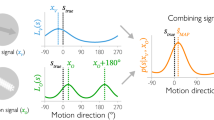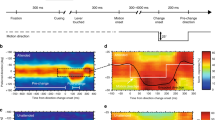Abstract
After adaptation of the visual system to motion of a pattern in a particular direction, a static pattern appears to move in the opposite direction—the motion aftereffect (MAE)1,2. It is thought that the MAE is not accompanied by a shift in perceived spatial position of the pattern being viewed3,4, providing psychophysical evidence for a dissociation of the neural processing of motion and position that complements anatomical and physiological evidence of functional specialization in primate and human visual cortex5,6,7. However, here we measure the perceived orientation of a static windmill pattern after adaptation to rotary motion and find a gradual shift in orientation in the direction of the illusory rotation, though at a rate much lower than the apparent rotation speed. The orientation shift, which started to decline within a few seconds, could persist longer than the MAE, and disappeared when the MAE was nulled by physical motion of the windmill pattern. Our results indicate that the representation of the position of spatial pattern is dynamically updated by neurons involved in the analysis of motion.
This is a preview of subscription content, access via your institution
Access options
Subscribe to this journal
Receive 51 print issues and online access
$199.00 per year
only $3.90 per issue
Buy this article
- Purchase on Springer Link
- Instant access to full article PDF
Prices may be subject to local taxes which are calculated during checkout



Similar content being viewed by others
References
Wohlgemuth, A. On the aftereffect of seen movement. Br. J. Psychol. Monogr. Suppl. 1, 1–117 (1911).
Mather, G., Verstraten, F. A. J. & Anstis, S. M. The Motion Aftereffect: A Modern Perspective (MIT Press, Cambridge, Massachusetts, (1998)).
Gregory, R. L. Eye and Brain (McGraw-Hill, New York, (1966)).
Nakayama, K. Biological image motion processing: a review. Vision Res. 25, 625–660 (1985).
Zeki, S. M. Functional organization of a visual area in the posterior bank of the superior temporal sulcus of the rhesus monkey. J. Physiol. (Lond.) 236, 549–573 (1974).
Zihl, J., VonCramon, D. & Mai, N. Selective disturbance of movement vision after bilateral brain damage. Brain 106, 313–340 (1983).
Livingstone, M. S. & Hubel, D. H. Psychophysical evidence for separate channels for the perception of form, color, movement, and depth. J. Neurosci. 7, 3416–3466 (1987).
Snowden, R. J. Perceived spatial position is altered by motion adaptation. Perception 27 (Suppl.), 49–50 (1998).
Spigel, I. M. The effects of differential post exposure illumination on the decay of a movement aftereffect. J. Psychol. 50, 209–210 (1960).
Ramachandran, V. S. & Anstis, S. M. Illusory displacement of equiluminous kinetic edges. Perception 19, 611–616 (1990).
De Valois, R. L. & De Valois, K. K. Vernier acuity with stationary moving Gabors. Vision Res. 31, 1619–1626 (1991).
Nijhawan, R. Motion extrapolation in catching. Nature 370, 256–267 (1994).
Baldo, M. V. C. & Klein, S. A. Extrapolation or attentional shift. Nature 378, 565–566 (1995).
Khurana, B. & Nijhawan, R. Extrapolation or attentional shift: reply. Nature 378, 566 (1995).
Anstis, S. M. & Remachandran, V. S. in The Artful Eye (eds Gregory, R., Harris, J., Heard, P. & Rose, D.) 232–248 (Oxford Univ. Press, Oxford, (1995)).
Merigan, W. H. & Maunsell, J. H. R. How parallel are the primate visual pathways? Annu. Rev. Neurosci. 16, 369–402 (1993).
Zeki, S. A Vision of the Brain (Blackwell, Oxford, (1993)).
Shipp, S. & Zeki, S. The organisation of connections between areas V1 and V5 in the macaque monkey visual cortex. Eur. J. Neurosci. 1, 309–332 (1989).
Shipp, S. & Zeki, S. The organisation of connections between areas V2 and V5 in the macaque monkey visual cortex. Eur. J. Neurosci. 1, 333–354 (1989).
Acknowledgements
S.N. was a visiting fellow at the Institute of Cognitive Neuroscience, UCL. We thank S. Naito and K. Ishii, NTT Communication Science Laboratories for their support. A.J. is supported by a grant from the EPSRC/BBSRC Mathematical Modelling Initiative.
Author information
Authors and Affiliations
Corresponding author
Rights and permissions
About this article
Cite this article
Nishida, S., Johnston, A. Influence of motion signals on the perceived position of spatial pattern. Nature 397, 610–612 (1999). https://doi.org/10.1038/17600
Received:
Accepted:
Issue Date:
DOI: https://doi.org/10.1038/17600
This article is cited by
-
Integration of Position and Predictive Motion Signals in Aging Vision
Scientific Reports (2020)
-
Apparent shift in long-range motion trajectory by local pattern orientation
Scientific Reports (2018)
-
Motion-induced position shift in early Alzheimer’s disease
Scientific Reports (2018)
-
Motion-induced compression of perceived numerosity
Scientific Reports (2018)
-
Perceptual shrinkage of a one-way motion path with high-speed motion
Scientific Reports (2016)
Comments
By submitting a comment you agree to abide by our Terms and Community Guidelines. If you find something abusive or that does not comply with our terms or guidelines please flag it as inappropriate.



